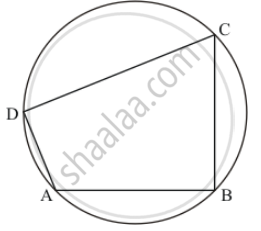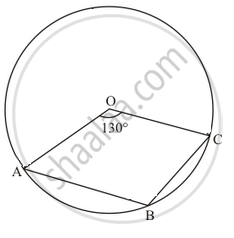Advertisements
Advertisements
प्रश्न
In a cyclic quadrilateral ABCD, if ∠A − ∠C = 60°, prove that the smaller of two is 60°
उत्तर
It is given that ∠A – ∠C = 60° and ABCD is a cyclic quadrilateral.

We have to prove that smaller of two is 60°
Since ABCD is a cyclic quadrilateral
So ∠A + ∠C = 180° (Sum of opposite pair of angles of cyclic quadrilateral is 180°) ..… (1)
And,
∠A – ∠C = 60° (Given) ..… (2)
Adding equation (1) and (2) we have
= 120°
So, ∠C = 60°
Hence, smaller of two is 60°.
APPEARS IN
संबंधित प्रश्न
If diagonals of a cyclic quadrilateral are diameters of the circle through the vertices of the quadrilateral, prove that it is a rectangle.
If the non-parallel sides of a trapezium are equal, prove that it is cyclic.
Two circles intersect at two points B and C. Through B, two line segments ABD and PBQ are drawn to intersect the circles at A, D and P, Q respectively (see the given figure). Prove that ∠ACP = ∠QCD.

ABC and ADC are two right triangles with common hypotenuse AC. Prove that ∠CAD = ∠CBD.
AC and BD are chords of a circle which bisect each other. Prove that (i) AC and BD are diameters; (ii) ABCD is a rectangle.
Two congruent circles intersect each other at points A and B. Through A any line segment PAQ is drawn so that P, Q lie on the two circles. Prove that BP = BQ.
If the two sides of a pair of opposite sides of a cyclic quadrilateral are equal, prove that its diagonals are equal.
ABCD is a cyclic trapezium with AD || BC. If ∠B = 70°, determine other three angles of the trapezium.
In the given figure, O is the centre of the circle such that ∠AOC = 130°, then ∠ABC =

In the figure, ▢ABCD is a cyclic quadrilateral. If m(arc ABC) = 230°, then find ∠ABC, ∠CDA, ∠CBE.

